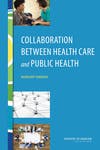Our goals in discussing prevention: Oral care counts
It is hard to believe that half of 2015 is gone already! I just returned from the ADHA Annual Session and Center for Lifelong Learning, and I am gearing up for RDH Under One Roof. The ADHA Center for Lifelong Learning and Annual Session were well attended and offered a wealth of information.
In one article in this newsletter, I discuss partnerships and collaboration to spread the word about prevention. Coincidentally, the Institute of Medicine released a new report titled, “Collaboration Between Health Care and Public Health: Workshop Summary.”1 The purpose of the workshop was: “Discuss and describe the elements of successful collaboration between health care and public health organizations and professionals; reflect on the five principles of primary care–public health integration (which can be applied more broadly to the health care–public health relationship): shared goals, community engagement, aligned leadership, sustainability, and data and analysis; and explore the ‘elephants in the room’ when public health and health care interact: what are the key challenges and obstacles and what are some potential solutions, including strengths both sides bring to the table.”
It was also mentioned “that dentistry and oral health are among the sectors that are often omitted”from collaborative efforts.2
Regarding the oral-systemic connection, we know that oral infections are one of the most common diseases, and they are also an important risk factor for heart disease. In the same article, we discuss that heart and cardiovascular diseases are the number one killer of men and women.
In an April 2015 press release, Thomas Van Dyke of the Forsyth Institute stated: "Given the high prevalence of oral infections, any risk they contribute to future cardiovascular disease is important to public health, unravelling the role of the oral microbiome and inflammation in cardiovascular disease will likely lead to new preventive and treatment approaches. The (oral) microbiome refers to the totality of microorganisms in a body part-in this case the mouth - that we all co-exist with.”3
Dr. Van Dyke was discussing a recent study with the following highlights: “There is evidence linking periodontal disease to cardiovascular disease (CVD); mechanisms linking oral infections to CVD involve actions of oral bacteria on the vasculature; systemic inflammation is an important component of the role of oral bacteria in the pathogenesis of CVD; and natural inflammation-resolving molecules may help to reduce the inflammation arm of the proposed periodontitis–CVD link without antimicrobial intervention.”4
With this and similar research, we can hope to see new prevention efforts and therapeutic options.
In another oral-systemic connection, Case Western Reserve University School of Dental Medicine and the Departments of Urology and Pathology at University Hospitals Case Medical Center reported on a study and stated that treating periodontal disease reduced symptoms of prostate inflammation, or prostatitis.5 The study was small, and the authors intend to conduct further studies, and to make periodontal treatment a standard part of treating prostate disease.
And last, but not least, enjoy Independence Day. While you enjoy your family and friends, and perhaps a parade, reflect on the meaning of the day. On July 4th, focus on the great gift of freedom given to us by our forefathers. Thank you to all who have served to protect our freedom and this great nation. Have a safe holiday.
Enjoy the newsletter, and I hope to see you in Las Vegas.
References
- Wizemann T. Roundtable on Population Health Improvement; Board on Population Health and Public Health Practice. Institute of Medicine Collaboration between Health Care and Public Health: Workshop Summary Released: June 24, 2015. The National Academies Press. http://www.nap.edu/catalog/21755/collaboration-between-health-care-and-public-health-workshop-summary.
- Ibid. p 55.
- Medical News Today Press release, April 17, 2015. http://www.medicalnewstoday.com/releases/292473.php.
- El Kholy K, Genco RJ, Van DykeTE. Oral infections and cardiovascular disease. Trends in Endocrinology and Metabolism, Volume 26, Issue 6, June 2015, Pages 315–321.
- Alwithanani N, Bissada NF, Joshi N, et al. Periodontal Treatment Improves Prostate Symptoms and Lowers Serum PSA in Men with High PSA and Chronic Periodontitis. Dentistry, 2015; 05 (03) DOI: 10.4172/2161-1122.1000284.
- http://www.rdhunderoneroof.com/index.html#showcase_3.





